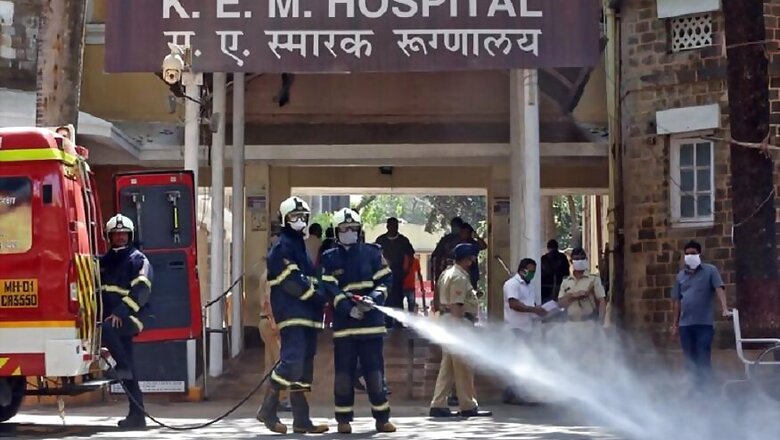
views
Long queues for admissions, a heavy inflow leading to more than one patient being accommodated on a bed, and an endemic shortfall of doctors and medical staff. For many who are often compelled to seek medical aid at the civic and government-run hospitals in Mumbai, these inconveniences are par for the course.
But the coronavirus pandemic and the resultant need for the middle-class and elite to seek treatment in these public health facilities has exposed them to these social realities.
For those who were spared the expediency of walking into these hospitals, the point was driven home by viral videos of physical distancing going for a toss as patients slept near dead bodies, and wards and corridors overflowed with the ill.
The rise in Covid-19 cases has led to these public sector facilities being overwhelmed further and stretched to their seams. The burden on these hospitals due to many private medical practitioners staying away from their regular practice has led to many government doctors and medical staff working round-the-clock in the most testing circumstances. As Mumbai fights an uphill battle against the rising tide of the pandemic, much is at stake for the Shiv Sena, which is the ruling party in the State and the Brihanmumbai Municipal Corporation (BMC). Shiv Sena President Uddhav Thackeray, who took over as the Chief Minister six months ago, faces a veritable trial by fire as he steers Maharashtra through the crisis in his maiden foray into electoral politics.
Ironically, the BMC, which is vested with the responsibility of dealing with this medical emergency, has been controlled by the Shiv Sena for three decades (1985-1992 and 1997-date). The BMC's poor civic governance and legacy issues stand out in this crisis.
The BMC, which is India’s richest civic body with a massive Rs 33,441 crore budget, controls a population of around 1.27 crore spread over a 482 sq km area. The Shiv Sena’s control over it helps sustain the party’s “reward economy,” and keeps its organisational apparatus in fine-fettle. But, the civic body has gradually seen its service levels and social infrastructure being run to the ground due to political neglect and tunnel vision.
Despite a three-tier healthcare system, covering primary (health posts), secondary (peripheral and specialty hospitals) and tertiary (four medical college and one dental college) facilities, the BMC, as insiders admit, has allowed this infrastructure to gradually go into a decline. Ironically, this has happened under the Shiv Sena’s watch.
Hence, when the crisis began to peak, the system had to scramble to ensure adequate ICU beds, oxygen support and isolation facilities.
Though the state government shifted out municipal commissioner Pravinsinh Pardeshi, and replaced him with I.S Chahal, in the middle of the crisis, due to an internecine fight in the upper echelons of the bureaucracy, sources admit the rot runs deeper.
While medical colleges and hospitals run by the state government and the BMC have traditionally seen a heavy influx of patients, stretching their capacity, the civic body and successive state governments have chosen to spend scarce resources to foster a politics of totems. This has seen crores being earmarked for memorials for icons like Chatrapati Shivaji Maharaj (Rs 3,600 crore), and Dr Babasaheb Ambedkar (Rs 1,089.95 crore).
The civic body has also mooted projects like the Rs 12,000 crore and 29.2km Coastal Road, which will connect the island city to the western suburbs. This has been criticised for its ecological impact and because it will largely serve car users.
Meanwhile, an almost decade-old proposal for a government-run medical college in Mumbai, to relieve the stretched public health infrastructure, continues to languish in the corridors of power.
As officials who have served in the BMC note, its administrators have failed to learn lessons from the civic body’s handling of medical crisis like swine flu, SARS, chikunguniya and the fallout of the 2005 flash floods that brought the city to a standstill.
Such crisis, they stress, are not to be dealt with from air-conditioned offices, but from the field, with a focus on community health perspectives. The BMC may have waited for coronavirus to flare up, rather than pre-empt it by launching aggressive, pro-active measures to screen residents of slums and lower-income group housing, which house over 60 per cent of Mumbai’s population.
Much before the term ‘mohalla clinics’ entered political lexicon, the BMC saw around 200 health posts being developed as part of an internationally-funded project in the 1980s. However, officials admit that these health posts were not strengthened and expanded in the coming years, leading to private healthcare providers taking over the primary healthcare space. Had these facilities been used optimally, the city’s public health infrastructure would have been much stronger, they note.
Mumbai is overrun by huge slum pockets, where hutments exist cheek-by-jowl, with families sleeping in shifts in 100 sq feet hovels, with no natural light or ventilation. This, and the prevalence of tuberculosis, makes the city a sitting duck for respiratory, aerosol-based diseases like Covid-19.
Successive state governments, too, deserve a share of the blame for legacy issues. Most urban renewal projects, including the Slum Redevelopment Authority (SRA) schemes, are builder and developer driven, rather than spurred by public interest.
As a former Congress MLA joked, considering the poor quality of construction in these “vertical slums,” a day will come when the state will be forced to launch a SRA-like scheme for redeveloping buildings redeveloped under these SRA schemes!
Dharavi, which has emerged as a COVID hotspot, is another example of red-tape and lack of holistic decision-making taking precedence over public interest. The Brownfield redevelopment and makeover of the area, which has emerged as an industrial hub, has been pending since 2004.
As residents joke with a tinge of regret, Lord Rama’s vanvas (exile) lasted for 14 years, but that of those from Dharavi is continuing 16 years on. Clearly, Dharavi, which was once derided as Asia’s largest slum, and the stomping ground of underworld don Varadarajan Mudaliar, worked hard to overcome this image emerge as a industrial powerhouse, but lost the battle to official apathy and vested interests.
Global tenders for the project, which is part of every political party’s manifesto due to the big bucks involved, were floated thrice. Last year, the state government shortlisted a developer for the Rs 26,000-crore scheme, but is yet to issue the final orders.
Local activists say with 60,000 families crammed into a 2.40 sq km area, Dharavi was an obvious candidate for a coronavirus-like epidemic. Physical distancing, which is touted as the holy grail of Corona prevention, is a cruel joke in this slum cluster, where multiple families share water taps and one toilet seat is used by an average of 200 people.
For those seeking light at the end of the tunnel, the present medical, social and economic crisis, once it blows over, may present an opportunity for a new order to rise from the ashes of the old. This may be an opportunity to rework the vocabulary of politics and recast the political discourse to one centered around the need for a robust social infrastructure rather than politics of identity and caste- based mobilisation.
A tall order, one may say, as for philosophers to become kings, the voters must philosophise!



















Comments
0 comment